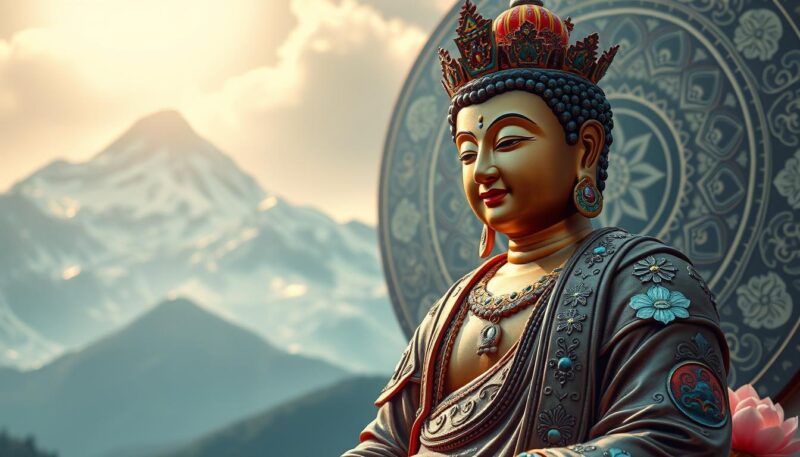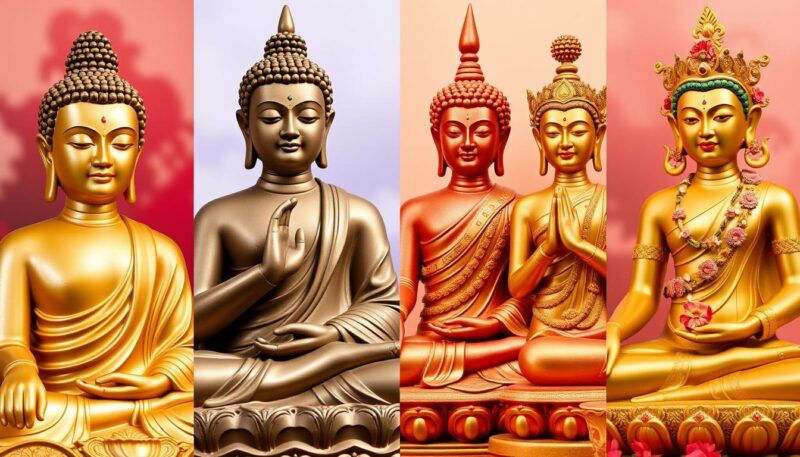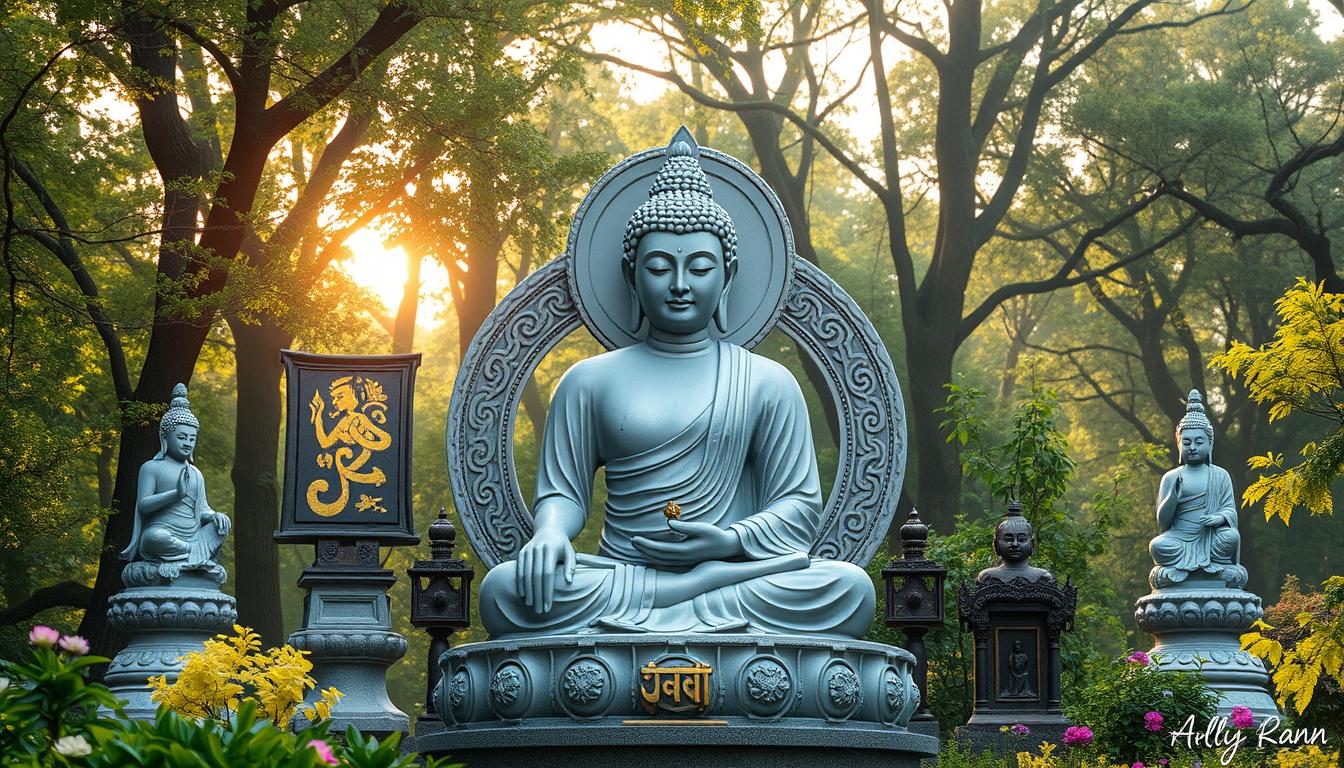When you think of Buddhist art and statues, one figure often stands out prominently: the Shakyamuni Buddha. This iconic representation is deeply intertwined with the cultural interpretations of Buddha, reflecting not only the teachings of Buddhism but also the artistic heritage of the regions it touches. Deep-rooted in the rich tapestry of Buddhism and art, the Shakyamuni Buddha statue embodies the historical Buddha, Siddhartha Gautama, whose journey from enlightenment to teaching forms the cornerstone of Buddhist philosophy. The significance of this statue transcends mere aesthetics, offering profound insights into spirituality, cultural exchange, and artistic evolution.
To truly understand the Shakyamuni Buddha’s significance, it’s essential to delve into its historical context. Originating in Central Tibet, a notable 12th-century Shakyamuni statue at The Metropolitan Museum of Art stands as a testament to the meticulous craftsmanship and enduring appeal of Buddha’s imagery. Crafted in brass with colored pigments, this statue not only captures the essence of Buddhist teachings but also portrays the art styles that have evolved through centuries. The converging influences of different regional styles make each statue a unique artifact, resonating with cultural interpretations of Buddha across diverse Buddhist traditions.
Interestingly, the Shakyamuni Buddha statue isn’t merely an object of admiration; it plays a central role in meditation practices. For practitioners, it serves as a focal point, promoting mindfulness and peace, and facilitating deeper connections with Buddha’s teachings. The various historical and artistic elements embedded in the statue make it a powerful tool for reflection and spiritual growth.
From the intricate iconography in Tibetan art to the influence of Kashmiri sculptural styles, every detail of the Shakyamuni Buddha statue tells a story. Whether it’s the ornate double lotus pedestal or the symbolic gestures (Mudras) like the earth-touching pose, these elements fill the statue with layers of meaning. They mirror not only the historical and spiritual journey of Buddha himself but also the artistic journeys that occurred through cultural exchanges among regions like Nepal, Tibet, and Kashmir.
Key Takeaways
- The Shakyamuni Buddha statue embodies the historical Buddha, Siddhartha Gautama, at the core of Buddhist philosophy.
- Originating in Central Tibet, notable statues like those at The Metropolitan Museum of Art reflect intricate craftsmanship.
- The statue serves as a focal point in meditation, promoting mindfulness and peace among practitioners.
- Influence of Kashmiri, Nepalese, and Tibetan art styles is evident in the detailed iconography of Shakyamuni Buddha statues.
- Key features like the double lotus pedestal and earth-touching pose add profound spiritual and historical significance.
Historical Context of Shakyamuni Buddha
The historical context of Shakyamuni Buddha, also known as Siddhartha Gautama, provides an exceptional foundation for understanding Buddhist teachings and enlightenment. Born in 563 or 566 B.C.E. in Lumbini Grove, near Kapilavastu, in present-day southern Nepal, Siddhartha Gautama hailed from a noble family of the Shakya clan. His transformative journey from prince to enlightened being, often referred to as “Sage of the Shakyas,” significantly influenced the spiritual landscape of his time.
The Life of Siddhartha Gautama
Siddhartha Gautama’s early life was marked by both privilege and tragedy. His mother, Queen Mahamaya, passed away seven days after his birth, leading to his upbringing by his aunt, Mahaprajapati Gautami. Despite the joys of palace life, Siddhartha encountered the harsh realities of existence—old age, illness, death, and asceticism—during his excursions beyond the palace walls. These encounters prompted him to renounce his kingdom at the age of twenty-nine and seek deeper truths.
The Enlightenment and Teachings
After six years of intense ascetic practices, Siddhartha realized that extreme deprivation was not the path to enlightenment. Shifting to meditation, he achieved enlightenment under the Bodhi tree in Bodhgaya at the age of thirty-five. This pivotal moment in the historical context of Shakyamuni Buddha was not just a personal triumph but a monumental event for spiritual seekers. His first discourse in Deer Park, Benares, introduced fundamental Buddhist teachings such as the four noble truths, interdependent nature, and karma.
These teachings, encapsulated in his role as a Sammasambuddha, or “perfectly enlightened one,” have endured through centuries, offering guidance on the path to enlightenment. The Buddha’s legacy continued to flourish when King Bimbisara of Magadha offered a monastery near Rajagriha. This served as a critical development for the sangha, facilitating the rapid growth of followers and solidifying the historical context of Shakyamuni Buddha.
The Jataka Tales recount storied past lives of Shakyamuni Buddha, including a significant prophecy by Dipankara Buddha, underscoring Siddhartha Gautama’s destined role as Shakyamuni.
Buddha’s parinirvana at the age of eighty marked the culmination of his earthly journey, with his relics enshrined in stupas across the region, especially in Bodhgaya, a major pilgrimage site. Statues of Shakyamuni Buddha, representing this enlightened figure, continue to be revered across various Buddhist traditions, each symbolizing the timeless teachings and profound philosophical insights.
Artistic Representation of the Shakyamuni Buddha Statue
The representation of Buddha in different cultures offers a captivating lens through which to understand the depth and influence of Buddhist art. Among these, Tibetan Buddhist art stands out for its intricate iconography and profound symbolism, reflecting deep spiritual significance. This art form beautifully encapsulates the essence of the Shakyamuni Buddha’s journey to enlightenment.
Iconography and Symbols in Tibetan Art
Tibetan Buddhist art is renowned for its detailed iconography and meaningful symbols. The depiction of the Shakyamuni Buddha often incorporates significant features that denote spiritual truths. Key elements such as the bhumisparsha mudra—the earth-touching gesture—serve to convey the moment of Buddha’s enlightenment under the Bodhi tree. Additionally, Tibetan Buddhist art features complex backgrounds often adorned with various deities and symbols which reinforce the central narrative of Buddha’s spiritual journey.

Influence of Kashmiri Art on Tibetan Sculpture
The Kashmiri influence on Buddha statues is particularly evident in the nuanced details of Tibetan sculptures from the 11th and 12th centuries. This influence brought a unique stylistic integration into Tibetan art, blending Eastern Indian artistic traditions with local elements. The distinct Kashmiri craftsmanship is visible in the ornate decorations and the fluid yet grounded posture of the Buddha statues.
Over time, the representation of Buddha in different cultures absorbed various stylistic influences while maintaining core spiritual concepts. The incorporation of decorative elements such as carved jewelry and precise anatomical details reflect the artistic heritage from Kashmir. This interplay between different artistic traditions has enriched the portrayal of the Shakyamuni Buddha, adding layers of cultural resonance and spiritual profundity.
Regional Variations in Shakyamuni Buddha Statues
The regional variations of Buddha representation reflect diverse historical, cultural, and artistic elements. These differences can be distinctly observed in the Indian Buddha sculptures and Chinese Buddhist art, each bringing unique influences and adaptations to the Shakyamuni Buddha statue.
Characteristics of Indian Sculptures
Indian Buddha sculptures are well-known for their powerful physiques and fine attire. These sculptures often show Siddhartha in robust and serene forms, capturing the essence of his enlightenment. A notable example is the standing Buddha in the Gandharan style, one of the earliest depictions of Siddhartha in human form, showcasing enlightenment and monastic simplicity. This period coincided with the establishment of the Kushan Dynasty, further blending Indian and Hellenistic influences. The seated Buddha from Katra mound in the Mathuran style further exemplifies India’s rich sculptural tradition, echoing the robust aesthetics from the Mauryan dynasty.

Chinese Interpretations and Innovations
Chinese Buddhist art excels in integrating local aesthetics into depictions of Buddha. During the Northern Wei dynasty, the stone carving of Shakyamuni Buddha at Longmen’s Binyang Cave beautifully blends Indian artistic styles with distinctly Chinese features. Additionally, the clothing styles in Chinese interpretations often adapt to local garments, reflecting a harmonious cultural integration. From there, the Chinese influence spread across East Asia, affecting regional interpretations and leading to innovations that further diversified the architectural significance of Buddha statues. The statue of Siddhartha Descending the Mountain in Japan, particularly revered in Zen Buddhism circles, is a poignant portrayal resonating with the values of perseverance and self-discipline emphasized by the Zen tradition.
These regional variations in Shakyamuni Buddha statues not only illustrate the adaptation of Buddhist art across different cultures but also underscore the rich tapestry of styles and interpretations that arose from the broader exchange of artistic and spiritual ideas. The portrayal of Buddha in either the Indian or Chinese tradition speaks to the profound impact these representations have had on spiritual and artistic practices worldwide.
The Role of Shakyamuni Buddha Statue in Meditation Practices
The Shakyamuni Buddha statue holds immense significance in meditation practices, creating a serene environment that encourages spiritual reflection and growth. Imagery of the Buddha serves not only as a visual anchor but also as a conduit for promoting mindfulness through Buddha images. Statues of Buddha in meditation pose foster a sense of inner peace and focus for practitioners.
Promoting Mindfulness and Peace
The presence of the Shakyamuni Buddha statue in meditation practices is essential for promoting mindfulness through Buddha images. Devotees often find solace and concentration by focusing on the tranquil representation of the Buddha. The serene expression and symbolic features like the urna and wheel of Dharma serve as reminders of the teachings and the path to enlightenment. This tranquility aids in fostering a peaceful state of mind essential for deep meditation.
Usage in Rituals and Offerings
The Shakyamuni Buddha statue also plays a crucial role in Buddhist rituals and offerings. Devotees frequently engage in various rituals, such as pujas, where offerings like flowers, incense, and water are presented to the statue. These practices are not mere traditional acts but are deeply spiritual, allowing practitioners to express devotion and reinforce their spiritual connection to the Buddha. Buddhist rituals and offerings surrounding the Shakyamuni Buddha statue thus underline its profound spiritual significance.
| Element | Significance |
|---|---|
| Urna | Symbol of spiritual insight and enlightenment. |
| Wheel of Dharma | Represents Buddha’s teachings and the path to enlightenment. |
| Elongated Ears | Indicate long life and wisdom. |
| Ushnisha | Symbolizes Buddha’s attainment of enlightenment. |
Overall, the integration of the Shakyamuni Buddha statue within meditation settings and rituals demonstrates its enduring importance in fostering spiritual growth and mindfulness in Buddhist traditions.
Cultural Significance Across Different Buddhist Traditions
The Shakyamuni Buddha Statue stands as a profound symbol across various Buddhist traditions, encompassing an array of cultural and religious significances. The perspectives of Mahayana and Hinayana Buddhism hold unique interpretations of these statues, contributing to a rich tapestry of spiritual practices.
Mahayana and Hinayana Perspectives
Mahayana and Hinayana Buddhism, the two major branches of Buddhist traditions, offer varied views on the role and depiction of the Shakyamuni Buddha Statue. In Mahayana Buddhism, statues are deeply embedded in ritual and symbolism. They represent not just the historical Shakyamuni in Buddhism but also the expansive qualities of enlightenment and compassion. These statues are frequently used during meditation, rituals, and ceremonial offerings, acting as focal points for spiritual aspiration and practice.
In contrast, Hinayana (or Theravada) Buddhism emphasizes the simplicity and austerity of the Buddha’s original teachings. Here, representations of the Shakyamuni Buddha are less ornate but no less significant. They serve to remind practitioners of the Buddha’s path to enlightenment and encourage a disciplined, mindful life in adherence to his teachings.
Tibetan Buddhist Interpretation
Tibetan Buddhism brings another layer of complexity to the interpretation and usage of the Shakyamuni Buddha Statue. Tibetan Buddhist traditions incorporate these statues into their intricate tantric practices and meditative visualizations, enriching the cultural and spiritual significance of the artwork. The statues are often lavishly adorned and crafted with detailed iconography that reflects the unique Buddhist theology of Tibet.
Moreover, Tibetan Buddhism places a strong emphasis on the symbolic power of these statues, considering them embodiments of divine presence. The images of Shakyamuni in Buddhism are thus revered not just as historical reminders but as living representations of the Buddha’s eternal wisdom and compassion. This belief underscores the role of the statues in both public worship and private meditation, knitting together the physical and metaphysical realms in a seamless spiritual experience.
| Aspect | Mahayana Buddhism | Hinayana Buddhism | Tibetan Buddhism |
|---|---|---|---|
| Role of Shakyamuni Statue | Ritualistic and Symbolic | Remindful and Disciplinal | Embodiment of Divine Presence |
| Usage in Practices | Integral in Meditation and Ceremonies | Encourages Mindfulness | Centrally Used in Tantric Practices |
| Aesthetic Approach | Ornate and Symbolic | Simple and Austere | Lavishly Adorned with Detailed Iconography |
Each tradition’s unique interpretation of the Shakyamuni Buddha Statue contributes to the overall cultural and religious fabric, emphasizing adaptability and resilience of Buddhism through centuries. These diverse perspectives not only enrich our understanding of Buddhist practices but also illuminate the deep reverence attached to the Shakyamuni Buddha across different cultures.
Shakyamuni Buddha Statue in Modern Times
In today’s world, the Shakyamuni Buddha Statue continues to captivate the hearts and minds of people across the globe. The influence of Buddha statues can be seen in various facets of contemporary Buddhist art, which often harmonizes traditional motifs with modern interpretations. The Shakyamuni Buddha statue, expertly cast from copper alloy and gilded with 24-karat gold, holds immense cultural and artistic value.
The preservation of Shakyamuni Buddha artifacts remains a focus, as these cultural treasures are safeguarded for future generations. Crafted by master artisans of the Shakya clan in Patan, Nepal, the statues represent the pinnacle of fine metalworking techniques passed down through generations. Efforts such as filling the statues with mantras, mandalas, and substances of all five elements ensure their spiritual potency.
The Influence on Contemporary Art
Contemporary Buddhist art has evolved significantly, with the Shakyamuni Buddha Statue playing a crucial role in this transformation. The melding of ancient techniques with contemporary styles results in artworks that are not only visually appealing but also spiritually resonant. These statues, often depicted in Bhumisparsha Mudra symbolizing enlightenment, inspire both artists and admirers worldwide.
- Prices for high-end Buddha sculptures reach up to $1,385.00
- 69 distinct products related to Buddha statues available
- Statues dimension: 12 × 21 cm and weight: 1.2 kg
- Sculptures handcrafted by the Shakya clan, known for their artistry
Preservation and Tourism
The preservation of Shakyamuni Buddha statues is not just about maintaining physical artifacts; it is about keeping alive the rich cultural heritage they represent. Buddhist tourism has flourished around these statues, drawing visitors to places like Lumbini, Nepal, the birthplace of Shakyamuni Buddha. Devotees and cultural enthusiasts find deep connections to these historical sites, enhancing the global appreciation for Buddhist art and traditions.
| Feature | Description |
|---|---|
| Material | Copper alloy with 24-karat gold gilding |
| Origin | Patan, Nepal |
| Artisans | Master artisans of the Shakya clan |
| Special Services | Mantras and mandalas filling |
| Tourist Attraction | Lumbini, Nepal |
Shakyamuni Buddha Statue
The Shakyamuni Buddha statue holds a remarkable place in the hearts of Buddhists around the globe. Serving as silent ambassadors of Buddhism’s timeless wisdom, these statues grace both public spaces and private sanctuaries with their serene presence. From majestic temples to carefully curated museums and private collections of Buddhist artifacts, these sculptures draw admiration and introspection from all walks of life.
Notable Statues Around the World
Among the most notable statues is the 71-foot tall bronze Shakyamuni Buddha statue situated in Hyogo, Japan. This awe-inspiring monument stands amid peaceful gardens, embodying the essence of tranquility and reflection. In Nepal, exquisite copper statues that require minimal maintenance for indoor use continue to captivate visitors with their intricate craftsmanship.
Across the United States, the influence of Shakyamuni Buddha is evident in places like the Pacific Asia Museum in Pasadena, California, where numerous Buddhist artifacts are displayed. Statues are often shipped from Oceanside, California, where specialized companies employ advanced packaging methods like the Instapak foam injection system and recycled peanuts to ensure the safe delivery of these precious art pieces.
Museums and Private Collections
Museums around the world, such as the Metropolitan Museum of Art in New York and the British Museum in London, house notable Buddha statues that provide cultural and historical context to viewers. These institutions meticulously preserve and display these artifacts, allowing the public to engage with Buddhism’s rich heritage.
Private collectors, too, play a vital role in preserving these sacred sculptures. Enthusiasts can acquire these statues, with shipping quotes instantly available through services like UPS. Detailed information and inquiries about these bronze statues can be directed to dedicated suppliers via email or phone, ensuring that each piece finds a proper home.
In conclusion, the Shakyamuni Buddha statue is more than a religious symbol; it is a global cultural artifact connecting the present with a storied past. Its widespread presence in notable locations, museums, and private collections highlights the enduring legacy and universal appeal of Buddhist iconography.
FAQ
What is the significance of the Shakyamuni Buddha Statue in Buddhist traditions?
The Shakyamuni Buddha Statue represents the historical Buddha, Siddhartha Gautama, whose teachings form the core of Buddhism. It serves as a focal point for meditation and admiration, embodying the spiritual and historical depth of Buddhist art.
Can you provide a brief historical context of Shakyamuni Buddha?
Siddhartha Gautama, later known as Shakyamuni Buddha, was a prince who renounced his royal life to seek enlightenment. His path to becoming the Buddha took place in the northeastern region of the Indian subcontinent, around 566 to 485 BCE, in what is today Nepal.
What significant moment is captured by the Shakyamuni Buddha Statue?
The statue often depicts Siddhartha Gautama’s moment of enlightenment under the Bodhi tree, a pivotal event that laid the foundation for Buddhist teachings and the philosophy of enlightenment.
What are some key symbols and iconography in Tibetan Buddhist art?
Tibetan Buddhist art features intricate symbols such as mudras, like the bhumisparsha (earth-touching pose), and figures of nine fierce goddesses around the Buddha’s halo, showcasing the influence of Kashmiri and Eastern Indian styles.
How have Kashmiri art styles influenced Tibetan sculpture?
Kashmiri art has significantly influenced Tibetan sculpture, especially between the 11th and 12th centuries, contributing to the intricate designs and iconographies seen in Tibetan Buddhist statues, including the Shakyamuni Buddha.
What are the characteristics of Indian Buddha sculptures?
Indian Buddha sculptures are known for their powerful physiques and fine attire, rooted in the rich tradition of Indian sculpture art, depicting the Buddha in a robust and dignified manner.
How do Chinese interpretations of Buddha statues differ?
Chinese interpretations include elements such as clothing adapted to reflect local aesthetics, highlighting a level of cultural integration and reinterpretation while maintaining the core symbols of Buddhist art.
How does the Shakyamuni Buddha Statue aid in meditation practices?
The statue serves as an anchor for focusing thoughts, promoting inner peace and mindfulness. It is often used in rituals and offerings, becoming a visual focal point for expressions of devotion and the quest for enlightenment.
What roles do Shakyamuni Buddha Statues play in Mahayana and Hinayana Buddhism?
In Mahayana Buddhism, statues serve a ritualistic role, symbolizing spiritual aspirations, while in Hinayana Buddhism, they play a less prominent but still significant role in aiding personal meditation and reflection.
How is the Shakyamuni Buddha Statue integrated into Tibetan Buddhist practices?
Tibetan Buddhism involves the use of statues within unique meditative and theological practices, adding layers of cultural and religious significance to the Shakyamuni Buddha Statue.
What is the influence of the Shakyamuni Buddha Statue in contemporary art?
The statue has significantly influenced contemporary art by intertwining traditional Buddhist motifs with modern interpretations. Contemporary artists draw inspiration from its historical and spiritual legacy.
What efforts are made for the preservation of Shakyamuni Buddha Statues?
Preservation efforts focus on safeguarding these cultural treasures from decay and damage. These include restoration projects and protective measures in museums and historical sites.
How does the Shakyamuni Buddha Statue contribute to tourism?
As an iconic element of Buddhist heritage, the statue attracts interest from both devotees and cultural enthusiasts, making it a significant aspect of tourism centered around historical and spiritual exploration.
Where can notable Shakyamuni Buddha Statues be found around the world?
Notable statues are displayed in prominent locations such as The Metropolitan Museum of Art, museums worldwide, and private collections, serving as cultural and historical bridges connecting past Buddhist traditions with the present.
How do private collections contribute to the preservation of Shakyamuni Buddha Statues?
Private collections play a crucial role in preserving the artistic and cultural heritage of Shakyamuni Buddha Statues, ensuring their care, and maintaining their visibility within the global context of art and spirituality.
Source Links
- http://indianculture.gov.in/artefacts-museums/buddha-shakyamuni
- https://www.buddhastatuesforsale.net/about-buddha-statues/development-of-buddha-statues/
- https://medium.com/@inventive_mauve_tortoise_897/harmony-in-sculpted-form-contrasting-buddha-statues-in-southern-and-northern-buddhist-traditions-2ff485165b55
- https://kagyuoffice.org/buddhism/shakyamuni-buddha/
- https://nepalstatues.com/shakyamuni-statues-real-buddha/
- https://www.termatree.com/blogs/termatree/shakyamuni-buddha?srsltid=AfmBOoqwR1JiB1BUvEgSjQhcJ_WFXfFrmAInvVS9_kUNlS13KR7wkuV7
- https://medium.com/norton-museum-of-art/the-passage-of-shakyamuni-buddha-into-nirvana-2ff67e4e321
- https://en.wikipedia.org/wiki/Buddhist_art
- https://www.buddha-statues.info/blog/the-difference-between-shakyamuni-buddha-statue-and-laughing-buddha-statue/
- https://www.lionsroar.com/why-do-buddhas-look-so-different/
- https://www.artic.edu/articles/799/buddha-shakyamuni-a-curators-insights
- https://wisdomexperience.org/ebook/the-power-of-mantra/1-shakyamuni-buddha/
- https://www.shakyahandicraft.com/buddha-statue/
- https://www.metmuseum.org/toah/hd/chbu/hd_chbu.htm
- https://www.metmuseum.org/toah/hd/budd/hd_budd.htm
- https://www.asianstudies.org/publications/eaa/archives/buddhist-art-styles-and-cultural-exchange-along-the-silk-road/
- https://dharmacrafts.com/collections/buddha-statues?srsltid=AfmBOope77mxOIT5hp0KJ1ns6mjHkKmS8oj_Wlg8MCZVv7X90euQU4lb
- https://rudraxis.com/shop/buddhist-statues/shakyamuni-buddha-statue/
- https://www.lotussculpture.com/Nepali-Earth-Touching-Buddha.html

